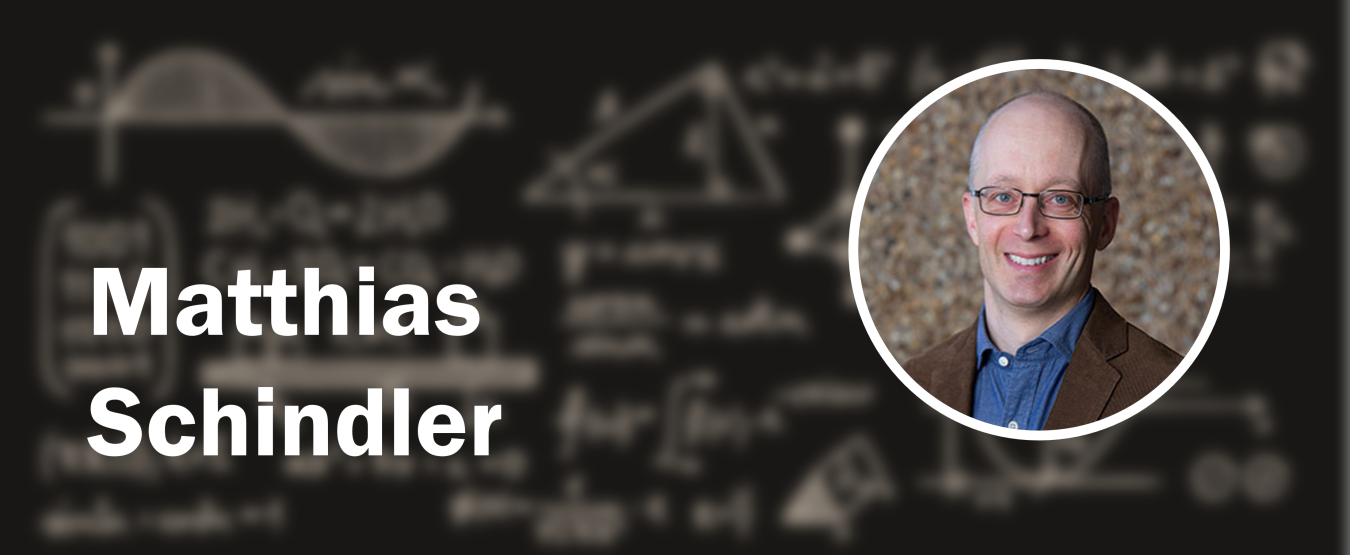With his Early Career award, Matthias Schindler developed theoretical tools to help us understand the processes inside of protons and neutrons.
August 11, 2025Sandra Allen McLean

Sandra Allen McLean (sandra.mclean@science.doe.gov) is a communications specialist for the Office of Science in the Office of Communications and Public Affairs. Sandra is responsible for identifying, curating, or creating lay-language content about Office of Science-funded research for DOE web sites, popular and trade media, and stakeholder education. She researches and writes the historical Milestone Tweets for the office Twitter account @DOEScience.
Sandra holds an associate degree in American Sign Language interpreting, a bachelor’s in science journalism and biology, and a master’s in Information Sciences. Her hobbies are sewing – especially costumes! – and lesesucht, compounded by extreme tsundoku.
WHAT DID THE 2013 EARLY CAREER AWARD ALLOW YOU TO DO?
The world around us is made of atoms. Each of these atoms contains a nucleus, which consists of different combinations of particles called protons and neutrons. These protons and neutrons themselves are very complex objects. They’re made up of even smaller particles that are subject to all known forces of nature. Understanding how all of this works is the goal of nuclear physics research.
In our everyday lives, we can tell left from right. In the nuclear world, though, things are different. The strong nuclear force that binds the protons and neutrons into nuclei does not change when we switch all three directions (left-right, up-down, front-back) to their negatives. This is referred to as parity symmetry. On the other hand, the so-called weak force does not obey parity symmetry, which is called parity violation. As the names imply, the strong force tends to dominate the weak one. In nuclear physics, parity violation is normally a very small effect and very difficult to see in experiments. Nonetheless, exploring parity violation allows us to refine our understanding of the processes that happen inside protons and neutrons.
I developed theoretical tools to study parity violation in light nuclei. (Light nuclei have relatively low numbers of protons and neutrons than other nuclei.) My work provided theoretical support for experiments performed at the Department of Energy’s Oak Ridge National Laboratory and at other research facilities. It is this interplay between theoretical and experimental research that has allowed us to make progress towards untangling what is going on inside nucleons.
The DOE Early Career Award provided me with the opportunity to establish a strong research program, from which I still benefit today. It also allowed me to share my research findings with others and to train students and postdoctoral researchers.
ABOUT:
Matthias Schindler is a professor in the Department of Physics and Astronomy at the University of South Carolina.
SUPPORTING THE DOE SC MISSION:
The Early Career Research Program provides financial support that is foundational to early career investigators, enabling them to define and direct independent research in areas important to DOE missions. The development of outstanding scientists and research leaders is of paramount importance to the Department of Energy Office of Science. By investing in the next generation of researchers, the Office of Science champions lifelong careers in discovery science.
For more information, please go to the Early Career Research Program page.
THE 2013 PROJECT ABSTRACT:
Title
Hadronic Parity Violation in Few‐Nucleon Systems
Abstract
The objective of this research is the detailed and model‐independent analysis and interpretation of the parity‐violating component of the interactions between nucleons. Resulting from the interplay of weak and strong interactions between quarks, the constituents of the nucleons, parity violation in nucleon interactions offers a unique probe of the forces and mechanisms that bind the quarks into nucleons.
Despite several decades of experimental and theoretical efforts, hadronic parity violation is still poorly understood. Recent progress on high‐intensity neutron sources, for example at the Spallation Neutron Source at Oak Ridge National Laboratory, makes it possible to study parity violation in few‐nucleon systems. This project will apply modern theoretical techniques to find a consistent description of parity‐violating interactions in a collection of different experiments and will also establish connections to lattice gauge theory and parity violation in more complex systems.
RESOURCES:
MR Schindler and RP Springer, “The Theory of Parity Violation in Few-Nucleon Systems.” Prog. Part. Nucl. Phys. 72, 1 (2013) doi:10.1016/j.ppnp.2013.05.002 [arXiv:1305.4190 [nucl-th]]
J Vanasse and MR Schindler, “Energy dependence of the parity-violating asymmetry of circularly polarized photons in in pionless effective field theory.” Phys. Rev. C 90, no.4, 044001 (2014) doi:10.1103/PhysRevC.90.044001 [arXiv:1404.0658 [nucl-th]]
MR Schindler, RP Springer and J Vanasse, “Large-Nc limit reduces the number of independent few-body parity-violating low-energy constants in pionless effective field theory.” Phys. Rev. C 93, no.2, 025502 (2016) [erratum: Phys. Rev. C 97, no.5, 059901 (2018)] doi:10.1103/PhysRevC.93.025502 [arXiv:1510.07598 [nucl-th]]
Additional profiles of the Early Career Research Program award recipients can be found at the Early Career Program highlights page.
The Office of Science is the single largest supporter of basic research in the physical sciences in the United States and is working to address some of the most pressing challenges of our time. For more information, please visit the Office of Science website.



